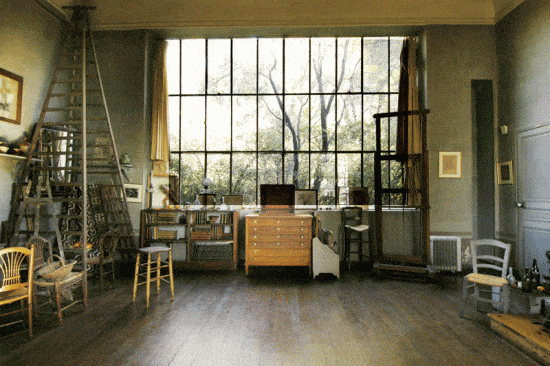
Natural light in Cezanne’s artist studio
Have you ever been half-way through a painting and suddenly the art studio light changes?
You carry on painting, hoping for a break in the weather, trying to remember the colour you’ve just mixed, and then the lighting changes.. again.
You think it won’t matter, it’s not that important, but the way you light your art studio can be one of the most cost effective ways of improving your painting and your colour mixing without buying another tube of paint.
One of the easiest methods of designing better lighting, is to simply change your light bulb.
But not all studio lamps are created equal.
From a £5 hardware store fluorescent tube to a £1,500 bespoke solution, the choices you make affect your ability to match colours accurately, judge skin tones effectively, and even feel a little happier by the quality of light you paint within.
With different options available you can have studio lighting the Old Masters would have been proud of…. without turning to shots of Absinthe.
Emergency chocolate biscuits needed
Trying to understand all the considerations when choosing my own studio lighting nearly led me to a lighting melt down! But bear in mind, I’m trying to design a bespoke studio where I’ll be painting 12 hours a day some days, through gloomy British weather and many a midnight painting session. So I need a space that has both natural light and the best quality artificial light.
There are so many variables and it’s such a specialist request that many Electrician’s will roll their eyes at you. With this tricky subject in mind, I have tried to created a summary of what you really need to know, and it can get a bit technical in places.
Do I really need to know this? I hear you cry!
Maybe, maybe not.
It depends on how much painting you do and your current lighting situation…
Artist studio lighting
As a painter I have worked in a range of studios with a variety of lighting, from the most fantastic natural brightness of light in the Mediterranean to orange incandescent bulbs that made my paintings look dull and dreary.
Finding a solution between natural lighting, artificial lighting and your budget can be a balancing act, depending on the subject you are lighting, your style of painting, space you have and funds available.
I’ve been struggling for years to find a simple, easy solution and have had many setbacks with my paintings along the way, trying to understand the difference between the lighting types, styles, colour temperatures, Kelvin’s, CRI’s the list seems to go on!
I’m currently just finishing building my new studio and thought it was the perfect opportunity for me to address all the art studio lighting questions I’ve had in the past and put them into practice in my new studio space.
Picture hanging vs picture painting
Generally, the light you use in your studio is nearly always going to be different to the specific lighting arrangements of where the painting will finally hang and be viewed in.
I’ve painted subtle grey tones before, that look fantastic on my easel, but I know from experience they would almost disappear if hung in a hallway without natural light.
I tend to paint in quite a bright space, the same light illumination levels you’ll usually find in an operating theatre, so when the paintings are displayed in a room with softer bulbs, the effect of the painting changes.
So, if you are commissioned to create a painting and have a chance of viewing the wall where the picture will hang, I’d say it is pretty critical to go and have a look.
It could be a bright conservatory or a dimly lit corridor and this can dramatically change how you approach the commission.
So what’s the best light to paint in? Let’s start with the artist favourite, North light.
The myth of North Light
All artists paint under North light, right?
That’s what we’re led to believe if you could only find the perfect window, the right size and the perfect height, that sends in soft North light, your paintings would be…perfect?
Not quite.
North light describes the location of the sun in the sky, having a window that only allows in North light helps to avoid having direct sunlight shine into the art studio while you work.
This is better for a painter because the light is more constant.
Notice how I didn’t say 100% constant, but more constant than the dramatic changes that happen with direct sunlight.
North light still changes.
Pro tip: North light only works if your studio is in the Northern Hemisphere, as a North lit artist studio in the Southern hemisphere will face direct sunlight coming through the window.
Windows and bounced light
The first thing to look at is where your window is.
Ideally, you would want a North facing window above your easel at about 35° angle from your canvas, so you get directional light on the canvas without getting glare.
Glare is most prominent if you are painting vertically with oil paints.
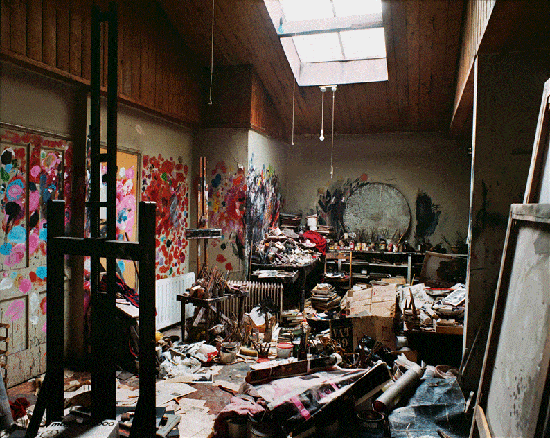
Photo: Perry Ogden, Francis Bacon’s studio – notice the position of the easel in relationship to the window
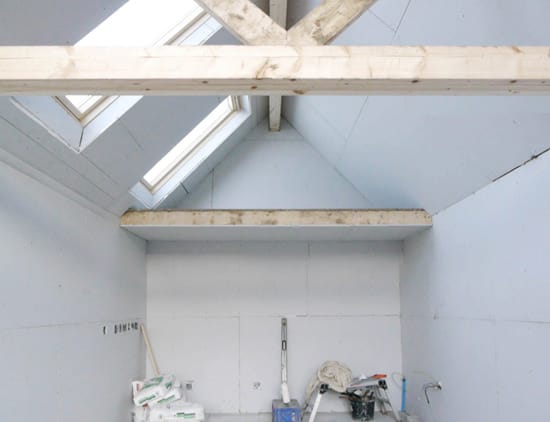
My studio halfway through the build – the side of my studio is North facing so I’ve installed 3 large Velux ceiling windows on a pitched roof
This gives me a nice spread of natural light if I’m working with the window light directly behind me or to the left side of me as I’m right handed so the canvas is always illuminated, similar to the position of the easel in the Rembrandt studio below.
If you have a large North facing window that is low (like Cezanne’s window light in his studio above) you have to be aware of bounced light.
This is where light from outside is coming in from the bottom of the window and then hitting the top of the ceiling in the studio – reflecting light from the ceiling down into the space.
If you’re trying to create a strong directional light effect, the reflected light from the ceiling can lessen the strong contrast, also, if you have any colour on the ceiling this will be reflected into your studio.
You just need to add a ‘hood’ over the top of the window to stop the light spilling up into the ceiling.
It’s like adding a barn door to a photography studio light – you’re just controlling the light coming into the space.
Depending on where you live in the world, the intensity of the light will vary, so a bright summers day in Italy, will be much more intense than a summers day in the UK.
Impressionistic or Classical?
If you paint in a more Impressionistic style, like Cezanne, reflected light can add to your set up, illumination of the space is your number one priority.
However, if you are only going to be creating highly dramatic, Chiaroscuro Old Master style lighting, then reflected light can pose problems.
You can go completely black in the studio, black walls, black ceilings, black floor, black clothes! but if you don’t manage reflected light then it can defeat the whole object of creating a space lit with one single light source.
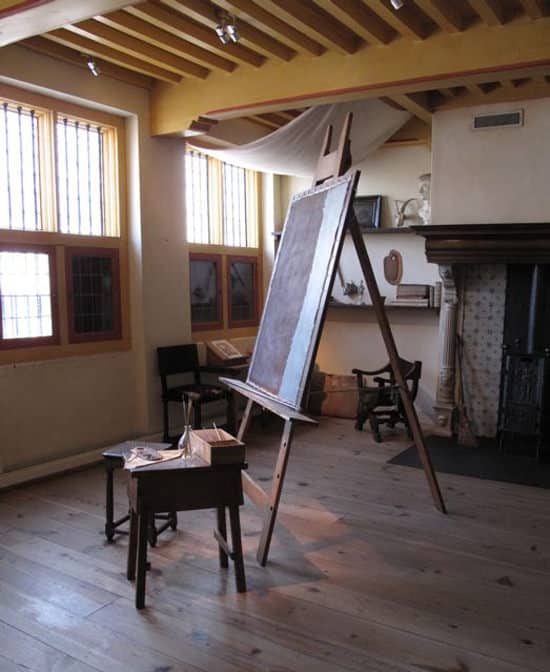
Rembrandt’s Art Studio lighting – Look at the low blackout windows and the canvas hood that prevents the light bouncing on the ceiling. You can read about my visit to Rembrandt’s studio here.
So, if you have a large low window, generally the bottom half should be covered with diffuser fabric so you get only light coming into your studio higher up, helping to illuminate your canvas without casting shadows.
Black out roller blinds can be very helpful in controlling the intensity of the light, the smaller and higher the light source, the more half tones you see in the subject.
Now we begin to enter the realms of artificial lighting.
What is colour temperature?
Have you ever seen a chameleon change colour?
Well, this is how light changes throughout the day, depending on the time of year, weather, and if you’re in the Northern or Southern hemisphere.
Just as different paint colours are called warm and cool, so are different light sources. And this can effect how you perceive colours in your studio.
With natural daylight, the changes happen subtly throughout the day, so initial colour change isn’t always apparent. However, when you’re concentrating and trying to paint a subject, you are battling against the perceived colours that keep changing!
This is why in Monet’s Haystack series he worked on numerous canvases as every couple of hours the light changed.
I overcome this in my studio by painting under a combination of natural and artificial light. For these to marry together we need to aware of the range of colour temperature of bulbs (often referred to by electricians as lamps)
Colour temperature
It’s called colour temperature because the scale originated from heating up Carbon to extremely high temperatures and the different temperatures produce a different colour.
If you were to heat carbon to 2426.85 degrees Celsius it would have a Kelvin of 2700K, and would glow yellowish-white.
If you heated carbon to 5126.85 degrees Celsius it would have a Kelvin of 5400K, and would glow bluish-white.
So the higher up the Kelvin scale (colour temperature) we go, the cooler and more blue the light.
So a lamp with a Kelvin of 6500K would be called a cool light.
So how does this relate to North light?
The kelvin of north light
The most common colour temperatures of light are as follows:
- A regular household incandescent bulb – 2,500K – 3000K and gives a nice warm light
- Office fluorescent light – 4,000K – 5000K and gives a cleaner, cooler light
- Noon Daylight – 5,500 K
- North Light (blue sky) – 7,500K -10,000K
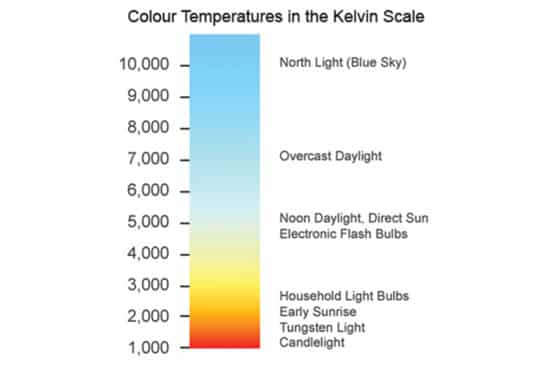
North light varies depending on if you live in the Northern or Southern Hemisphere, but in general North light/ blue sky is around 7, 500 – 10,000 Kelvin and if you were to mimic this is a lamp would be far too blue/cool to paint with.
In my studio, because I need artificial light as well as natural light I aim for a lamp of between 5000K – 5500K, this gives a white light rather than it having a cast of being too blue or too orange.
But just relying on Kelvin isn’t the only consideration, it’s number 1 on your tick list but you could buy a cheap bulb with a 5000K but if it hasn’t got a full spectral range, referred to in the industry as a CRI rating, then it might not be as accurate as you think.
CRI (pronounced ‘cree’ not C.R.I like F.B.I as I first thought!) stands for Colour Rendering Index.
This is the ability of a light source to render a full spectrum of colours to our eyes.
Colour rendering index CRI
So, the next thing we have to consider when choosing a lamp is the colour-rendering index (CRI), this indicates a light’s ability to illuminate colour accurately.
Natural daylight has a CRI rating of 100, this is what ideally we’re aiming to mimic in a lamp.
The more balanced the rendering results are, the higher the CRI will be.
Pro tip: ‘Full spectrum lighting’ is a phrase used by the lighting industry to denote bulbs that mimic the properties of sunlight, but some bulbs/lamps described this way perform better than others. So for example, you could have an artificial light source that renders blues and reds accurately but doesn’t have a strong yellow in its spectral curve so the rendering of the yellow will be duller.
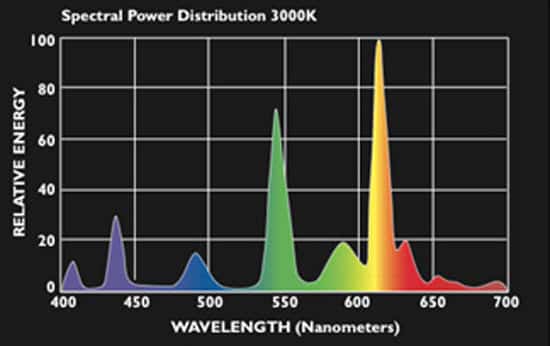
Here you can see this has a very spiky, spectral curve, so doesn’t offer an even colour rendering.
Colour is created by the selective reflection and absorption of the colours in the visible spectrum by the painting’s pigments.
This is really important for the lighting in your studio so you can mix a full range of colours accurately.
The higher the CRI score (out of 100) the more accurate to a full spectrum colour, the light source. Bulbs with a CRI of 80 to 100 are best at revealing vibrant, natural hues.
With artificial light, we’re looking for a light source that is ideally over 90 and as close to 100 as possible. Different lamps have different colour rendering indexes. This indicates how smooth, or how ‘spiky’ the light source is. If the source has spikes in it or is not well balanced you get an illumination that has flat rendition of some colours.
Just as a note, the highest CRI rating lighting manufacturers produce with a 5000K – 5500K is currently around 98.
Pro tip: The correlated color temperature (CCT), measured in Kelvin, refers to how warm or cool a light appears. Too warm a bulb may tint work reddish yellow, whereas too cool a light can turn things blue. For a good balance of warmth and coolness, look for bulbs with a CCT of 5500 K, the equivalent of midday sun. If you prefer cooler light, akin to north light, look for bulbs rated 6500 K.
Lumens, lux & light output
And finally but very importantly the next (and almost last) thing to consider is luminosity or brightness.
This is different to Kelvin or CRI, this is the lamps lumen rating or wattage rating.
Light measurement
Light measurement is complex. It is difficult to compare products when manufacturers provide performance in different formats. Wattage is the measure of how much electrical power a light source uses, not how bright it is. For a true comparison of output, lumen is the best measure to use.
The lumen is the measure of luminous power of a light source as perceived by the human eye. Lumens describe how much light in total is emitted from a light source.
What are lumens?
Watts measure the amount of energy required to light products, whereas lumens measure the amount of light produced.
The more lumens in a light bulb, the brighter the light.
Using lumens helps you to work out how bright the space will be, regardless of the type of lamp you are using.
For example: You could have a LED down-light, a Compact Fluorescent Lamp and an Incandescent bulb that all have different wattage per bulb but by using Lumens you can work out the light output produced.
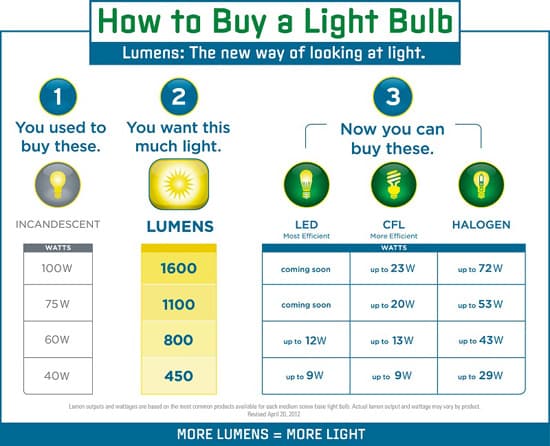
- 40-watt incandescent bulb = 450 lumens
- 29-watt Halogen = 450 lumens
- 9-watt LED = 450 lumens
- 9-watt Compact Fluorescent Lamp = 450 lumens
So to clarify, generally, total light output from a light source, regardless of the direction the light travels, is specified in lumens (lm).
So can I just find a handy lumen comparison chart to see how many lamps I need for my studio space?
You would think!
But there are so many variables that there isn’t a one size fits all and to complicate it further to describe the amount of light that hits a specific surface eg: your canvas, another term is used called Lux or Footcandle depending if you work in meters or feet.
Lux is defined as the level of brightness at a particular distance from the light source.
So the further from the light source the less the Lux level.
The formulas for measuring how much brightness you will need in your space are complicated, I found trying to work out light fallout, ceiling height, diffusers on lamps, beam spread etc.. really difficult to calculate!
Simplest solution
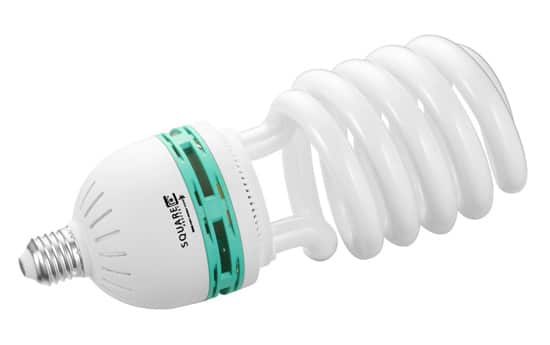
My top tip for lighting a small art studio with a ceiling height of 8 – 10 foot, is a bulb you can just screw into your existing fitting and is a Compact Fluorescent Bulb.
It should have a 90+ CRI rating, 5000K- 5500K colour temperature and around 85 watts, it will give a light output of around 5000 lumens at the lamps source and will give you a bright, clean light to work under.
Pro Tip: The light strength diminishes as the light is moved further from the source so by the time it hits your canvas it would probably be a 2/3 of the strength, around 1,800 lux – based on you sitting 1.5 meters away from the lamp in the ceiling.
The recommended lux level for detailed drawing work or very detailed mechanical work is 1500 – 2000 lux so this would fit the bill! Hurray!
However, 1500 lux is still very bright and I would imagine for most home studio situations, this bulb would give out ample illumination.
For many classical paintings, a lux level of 250 – 450 lux can still work very well, especially if your finished piece is going to be hanging in a darker space.
The lux value changes depending on how far away from the source you are painting, the angle of the beam etc.. but this lux calculator is very handy if you want to check your own studio and find a light level that works best for the style of work and type of paintings you are going to be creating.
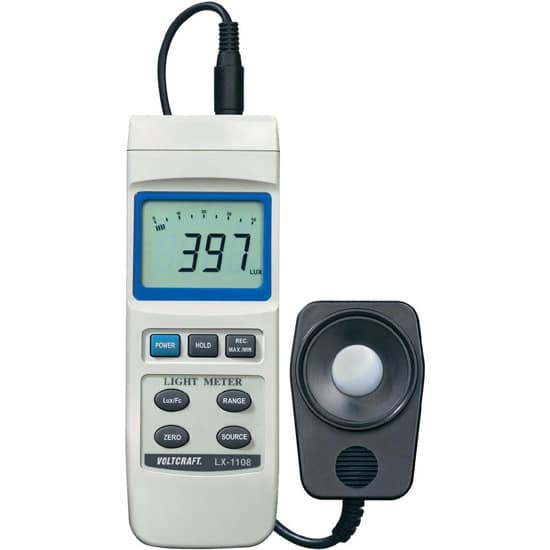
Lux can be measured by a Lux meter if you want to get super pro
A brief lamp overview
Here’s my overview of lighting and how to choose the best solution for your own space.
Incandescent Household Lamp
These are very inexpensive, have a high CRI rating 95+ but are a very warm light resulting in you actually painting things cooler than you would like, not the best choice for an art studio. Incandescent light bulbs are being phased out in favour of more energy-efficient lighting.
Compact Fluorescent Lamp (CFL)
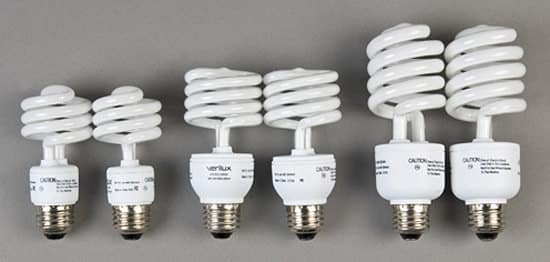
A compact fluorescent lamp (CFL) is a type of fluorescent lamp. Many CFLs are designed to replace an incandescent lamp and can fit into most existing light fixtures formerly used for incandescent light bulbs but generally use less power, have a longer rated life and give the same amount of light, but at a higher purchase price.
They generally have a lower CRI rating of 80 + (you can find odd ones that are higher) but Kelvin can be 5000K – 5500K.
CFLs radiate a different light spectrum from that of incandescent lamps, but are becoming more similar in colour output to the standard incandescent light bulb.
Halogen Lamp
A halogen lamp consists of a tungsten filament sealed in a compact transparent envelope filled with an inert gas and a small amount of halogen such as iodine or bromine. The halogen iodine or bromine increases the lifetime and the luminous efficiency of the lamp. Halogen lamps reach a luminous efficiency of approximately 25 lumens per watt (a conventional incandescent light bulb is approximately 15 lumens per watt and a compact fluorescent lamp is approximately 60 lumens per watt).
Halogen bulbs are smaller than conventional light bulbs and usually found in recessed task lighting, CRI is high but colour temperature is usually very warm.
Full Spectrum Halogen Lamps
Want to light your painting like the Mona Lisa?
Then you need to invest in some Solux bulbs.
These bad boys are used in museums globally, such as The Louvre in Paris, Guggenheim Museum, NY & The Van Gogh Museum to name a few. The CRI rating and spectral curve is amazing and for artificial lighting that best illuminates natural daylight, you can’t get much better.
So, have we found the perfect solution?
It depends.
If you work small and have a friendly electrician these can be a great solution, there is a 4 lamp track available that gives a great value spread light, however, the halogen light has a spot effect, rather than bringing up the illumination of the room.
So for lighting the Mona Lisa, perfect.
For creating an ambient light in your studio?
Harder to achieve.
The lights are often used for photography proofing of colours, so have been designed on a track system for illuminating a wall.
The halogens also run hotter than the fluorescent’s and use a touch more energy. Also they are harder to track down in the U.K.
Solux bulbs are the best halogens on the market, but they are expensive compared to lifespan/ cost ratio of fluorescent bulbs.
Pro Tip: They produce an amazing reading lamp for a lovely quality of light.
Full Spectrum Fluorescent Tubes
These tubes are probably the next best thing indoors to North light for most artists wanting a good illumination of the whole space.
They are relatively cheap and efficient and have good color indexes on the more expensive tubes.
The light source of a fluorescent tube is mercury and the light that mercury produces gives of ‘spiky’ lightwaves, the light isn’t an even spectral curve.
To combat this, manufacturers coat the inside of fluorescent tubes with a phosphor coating.
The phosphor coating helps to smooth out the spiky light wavelengths and gives a more even spread of colours.
So for lighting an artist studio we’re looking for a tube with a ‘tri-phosphor’ coating.
Good quality ‘triphosphor fluorescent’s use three phosphors to give off red, green and blue light. This tricks your eyes into thinking they are seeing white, in much the same way as a TV screen works.
Specialist fluorescent’s are available with a CRI higher than 90%, but these are slightly less efficient and are usually only used by professionals such as graphic designers or artists.
I will be using full spectrum fluorescent’s to light my studio, the lamps I’m going to go for are Philips TL-D 90 Graphica Pro Triphosphor 4′ T8 36 Watt Fluorescent Tube 36W,
They have a Kelvin of 5300K and a CRI of 98 and I can create a bank of lights to mimic diffused daylight whilst ensuring the lux level is going to be high enough.
On a happy note, as the bulb mimics natural daylight it’s ideal for sufferers of Seasonally Affected Disorder or S.A.D, so gives a feel-good factor whilst you work!
A note on fluorescent lamps
In fluorescent tubes, there is a number that represents the diameter of the tube.
The tubes I’m using are called a T8 and the industry are in the process of phasing them out, along with the T12 in favour of more energy efficient bulbs.
The T5 and LED’s are the alternatives but I’ve yet to find either that offer a high enough CRI rating, however, I believe over the next couple of years with developments in manufacturing there will be a more energy efficient like for like replacement.
Phew! hope it helps with setting up your art studio space.


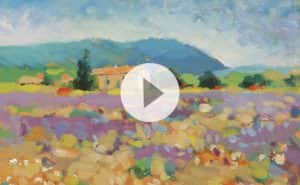
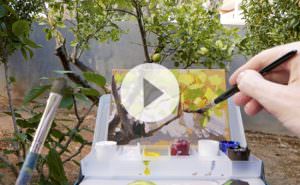
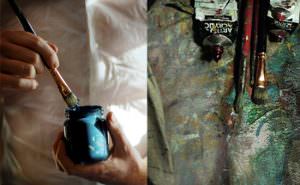
Excellent share of your experience and knowledge. Simplified and explained very well.. thank you. Got me thinking of a few new issues setting up my studio but ironed out a few problems I had too.
Pleased you found it helpful Chamindra.
Will
Hi Will, what an all encompassing explanation of the how’s and whys of lighting a studio. I’ve been wrestling with what to do as my studio will temporarily be in my basement. I find the 5500k to be too blue for my liking. They are CFLs from a photography set up. I don’t know the CRI or lumens on them, though. Some experimenting with guidance from what you’ve written here is going to help. Thanks.
Pleased it helped Alfred, you can always add some sheets of Rosco of LEE filters over the lights to warm the colours to your liking if you’re using softboxes.
Cheers,
Will
Fantastic article, Will! It’s very hard to find anything this comprehensive on the net. Just one thing though: the syndrome that daylight bulbs are good for is called Seasonal Affective Disorder not seasonally affected disorder. Cheers, Jenny
Pleased you found it helpful Jenny, thanks for the note on Seasonal Affective Disorder, good to know.
Will
When I started looking for the Philips full spectrum bulbs that you listed I found that they are designated differently for the U.S.
I found that searching for Philips 209056 F32T8/TL950, came up with bulbs that are close to the specs you listed for the ones you use.
Hopefully this will be helpful to someone,
~Cam
p.s. Thank you for putting this all together
Hi Cam, thanks for the info on the different bulb names available in the U.S, much appreciated.
Will
Wow!! New to your site! Thank you for this lighting explanation. It is way beyond anything I can undertake, but the information is great reading! God bless, C-Marie
Dear Will,
I hope to start water based painting at my kitchen table at night and I like to do close, fine work. Could you please recommend the best natural light bulb for a budget anglepoise lamp?
Hi Michelle, if you look for a 5000K (Kelvin) colour temperature that will have a white light and ideally a high Colour Rendering Index (CRI.
The 5000k are mostly under photography bulbs as most households bulbs tend to be warmer (2,700K – 4,000K). They are usually CFL bulbs, but LED lights are getting better and better and don’t produce as much heat so can be good if you’re working at a close distance, I don’t have any specific recommendations as I tend to work under the studio lights, but hope this helps.
Will
As a point of information, I found 5000k CFL bulbs with a high CRI at (1000 bulbs . Com) I didn’t want to put up the link, so just remove the spaces to get to it. I have no affiliation with the company other than I have ordered 5000k bulbs from them and were very pleased.
Cheers for the tip Alfred.
Will
Wonderful article – thank you! With the advent of LEDs, though, I’m finding it hard to choose between halogen, CFL and LED lights for my studio. I’d like to approximate natural light as much as possible. Any thoughts?
Hi Lee, nice to hear from you, yes, LEDs are getting better and better in their CRI ratings. They will produce less heat and energy than halogen and CFLs but will cost slightly more for the same Colour rendering and output.
Cheers,
Will
Hi Will,
Thanks so much for your article! It’s incredibly helpful but I must be dense because I still need some help understanding. I’m renting a condo and am looking to buy a floor or table lamp for the space I do my paintings in because the lighting is horrible. I wanted to use the CFL bulb you recommend in your “simplest solution” section but I feel like I’m missing something. I can’t just buy a lamp that accommodates a 100 watt bulb, can I? Everything I’ve read states that the CFL wattage needs to be lower or equal to its equivalent in incandescent. So, for example, a 13 watt CFL could go into a lamp allowing for up to 100 watts. The CFL you recommend at 85 watts would be equivalent to 800 watts incandescent. I can’t for the life of me find any lamp/fixture that accommodates this but for a photography setup. Am I confused?
Hi Antoinette, yes, that’s right, this type of bulb is pretty big and bright and usually used in photography studio setups. It depends on the space you’re trying to illuminate. If it’s just for a tabletop set up you could go with a lower wattage (like a 13 watt) There might also be some LED bulbs now available that will run slightly cooler than the CFL’s if you’re working closer to the bulb.
Will
Hi,
I would like to know what is the ideal height at which the bulbs ave to be placed to see natural colour. I work with garments all day and work on reproducing the colour of these onto images. I work with 90 CRI bulbs, and do not want to place them too low, so that the colours look brighter, and also not too high that they look darker.
Hi Vidhu, it depends on the work you’re doing, but I’ve found having more lights higher will give you a more even illumination due to the effects of the inverse square law. The lights in my studio are about 12ft from the floor.
Cheers,
Will
Hi Will,
Thank you for such an informative article!
In recent searches, I’ve come across several LED products that claim high CRI and daylight white color temperature. For example: https://store.waveformlighting.com/products/northlux-95-cri-6500k-br30-led-bulb-for-artwork-painting
Any thoughts on whether they would be appropriate for an art studio?
Steve
Hi Steve, the CRI looks good, but personally I find the colour temperature of 6500K a little too cool, around a 5000K is more neutral and less blue.
Hope this helps,
Cheers,
Will
THANK YOU!!!
Hi Will.
I am building a new art studio. It will be 7 metres x 5 metres. It will be my own personal studio but I will also hold classes a couple of days a week.
The ceilings will be 10 foot high. How many flourescent bulbs would you recommend to light the whole space. I do have plenty of daylight but I want it nicely lit in the evenings also.
I will be using the Philips flourescent bulbs you chose for your own studio.
Thanks for any help you can give me.
Hi Sean,
It will depend on the overall illuminance level you’re after both for personal and classes and the distance the fittings are from the working area (if you stand to paint or work on the flat). I have 2 banks of 6 x 36 watts, 4ft bulbs, so that’s 12 bulbs next to each other, about 5-6ft from the canvas height. This gives a max illuminance of around 1000 lux that I can drop by switching off individual tubes. If you have a lux meter you can test to see your current lighting illuminance to see what you prefer. Hope this helps.
Cheers,
Will
Hi Will,
Thanks so much for all this succinct tutorial – it is amazingly helpful! I am outfitting a new basement studio (it does have some decent natural light for a basement) and I’m wondering if you have any LED tube’s that fit the CRI 95-100 / 5000-5500K bill to recommend? (seeing that you wrote this article back in 2013!) Thanks very much, Stephanie
Hi Stephanie, nice to hear from you, there are some great looking NorthLux T8 tubes from waveform lighting in the US that have a full spectrum LED tubes. I haven’t personally tried them but they look ace!
Cheers,
Will
Thanks so much for this excellent article! I am an artist / photographer in a small town setting up a studio in my garage (talk about a dark space!), and I have difficulty even finding a store clerk who understands the issues involved, much less one who can point me to the best product for my needs. This will be no end of help to me.
Hope it helps Marjorie, there are numerous new LED light fixtures now on the market aswell, hope it helps to give you an idea of what to look out for.
Cheers,
Will
Excellent discussion of artificial lighting. Surprisingly, cool white fluorescent lamps are the least expensive to produce and are used mostly for workshop or utility lighting. A good thing for an artist. But a CRI above 90 would cost more, of course.
Please add to your discussion LED lighting. I suspect that the opportunity now exists for LEDs to provide a truer representation of Daylight (not a spiky spectral representation). With rebates, ever lowering costs to purchase and to operate, and somewhat less heat generated, they may be the ideal solution now.
Cheers Ken, yes LEDs are getting better and better at the moment, if you come across any like for like tubes let me know.
Will
Will, I read your lighting ongoing comments, and answers with great interest. For YEARS, I have been an artist working with silk threads on linen – a near lifetime project (interrupted by gainful employment. I am trying to figure out lighting for my small current work space. I am going blind (macular degeneration) and losing color definition gradually. I am trying to change my medium, and the scale of my work (rarely more than 18″ x20″ framed). I have enough space for lighting fixtures, and also have three north facing windows that are marvelous. My preferred lighting was natural light for years. Chinese silk thread manufacturers offer mire than 450 different numbered colors in a complete array, so color is the most important feature in the designs.
My dexterity is compromised as well, and needle threading itself is a thing of the past. To use my linen and silk materials, I may begin attempting punch-needle work, or possibly move toward paint. Being a realist, I know this will time-limited art for me, but light is the absolutely critical element in any further art creations in my life. I still can see well enough to work on a sewing machine, but my sight is fading at an accelerating pace. Have you any suggestion about where I could find information a bout ‘best lighting’ options for people transitioning into the darkness? It may seem like an odd problem, but others I know in my situation have essentially given up on further light improvement in their lives. Amazingly, I have had pretty good successful using ever changing forms of lighting over the last several years, despite this progressive darkening.
Thanks for reading this. I welcome comments from anyone who might have experience with this (most unwelcome) transition. I was so glad I persisted as I saw years passing over the span of your very informative site!
Hi Charlane, thanks so much for sharing your story. The reading lamps from serious readers.com, although more expensive than others, utilize the fantastic lighting for detailed works. They are dimmable and beam adjustable so can be tailored to adjusting the lighting levels in your room over time. The colour rendering is a 99% CRI so they feel very natural light.
Will
Hi Will,
Wow this article is great! I have a 16x 19 foot room with 7′ celling. I usually paint sitting down. Can I use a celling fan with four lights on it to light my studio? With four 85 watt bulbs in it? Or will this be too bright?
Thank You,
Debbie
Hi Debbie, one or even two bulbs would give you a good illumination, as they are quite large bulbs. Having the option to add a couple more is always handy though!
Will
Hi Will,
ok that’s what I was thinking too. I’ve had this article bookmarked on my computer for some time now. This was very helpful. Thank you soo much. I have a Facebook business page if you’d care to check it out. Google : Deborah Barbaccia – Artist, you should be able to pull it up that way.
Debbie
Thanks Debbie
Hi Will,
Firstly, thank you! I love your site and your courses – you are an excellent teacher and holy-cow, what an artist!
I am currently choosing lighting for a studio and your information is enlightening :-)
You wrote about florescent tubes, ‘They have a Kelvin of 5300K and a CRI of 98 and I can create a bank of lights to mimic diffused daylight whilst ensuring the lux level is going to be high enough.’
What did you mean by creating a ‘bank of lights’? Have you positioned several of these tubes together and are they on the ceiling? Or were you referring to a tube on the ceiling and then a collection of other lights? If so, which would they be?
Thank you and kind regards,
Caroline.
Hi Caroline,
What did you mean by creating a ‘bank of lights’? Have you positioned several of these tubes together and are they on the ceiling?
Yes, several tubes close together on the ceiling.
Will
thanks so much for this information Will – exactly what I wanted to know about lighting in studios :)
So pleased it helped Leanne.
Will,
I am a photography student and have enjoyed reading many of your articles. We have been studying Rembrandt to learn about lighting techniques. In looking at his workshop there has been much debate about the piece of canvas in the top left corner. You mentioned that is was to keep the light from reflecting off the ceiling. Just wondering how you came to this conclusion. Thank you.
Hey Stacey, just the way the light was falling in the space. I would have used it for preventing bounced light, of dropping down in front of the window to diffuse the light. Using muslin as diffusion can make a really pleasing soft light source.
I was amazed at how thoroughly you explained artist studio lighting. You also spent great effort replying to the comments. Well done.
Hey Joe, really hope the article helped.
Cheers,
Will
Hi Will,
This is a fantastically helpful article – many thanks indeed! I’d not heard of you before, but this article got me on your site, so I’ve now signed up to your newsletter which I’m looking forward to. Are you still using the same fluorescent lights as when you wrote the article or have you found any upgrades since then – maybe something more energy efficient?
Hi Jenny, nice to have you along. Yes, since this article was written there has been lots of developments with LED technology which is more energy efficient and also having higher CRI levels. I’m using the fluorescents in my current studio but will be looking to update to LED in my new studio space.
Cheers,
Will
It’s now 2023 — and a lot of developments in types of LED lights available. How would you update your recommendations for choices now?
Hi Robert, yes, I’d either use a photographic light or a main LED fixture that has a higher CRI. Where are you based? Waveform lighting in the US does a great range suitable to retrofit into existing fluorescent fixtures of screw-in lighting fixtures.
Will